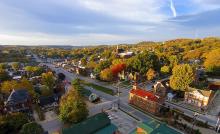This Small Missouri Town Wants to Pair Wine With Fiber
People and businesses in the small town of Hermann, Missouri, primarily rely on slow DSL for Internet access. There are also a few areas with cable connections available, and even a few parts of town where no ISPs offer service. This month, community leaders took decisive action to bring another option to town — they adopted a resolution to pursue federal funding for a publicly owned fiber optic network.
Let the People Decide
Late last year, Mayor Robert Koerber proposed a spring non-binding referendum to determine how strongly Hermann voters wanted to invest in the project. At the time, the Board of Alderman were considering a bond issue to cover the cost of deployment, which they estimated at $2.6 million.
Koerber thought that a strong outcome in support of the project would help attract financing when it was time to begin the project. He also considered the issue something voters should weigh in on, due to the bonding question.
The Board of Alderman supported the idea, but other town matters, including finding a new tourism and economic development director, required immediate attention. Town leaders also decided to look for some one who could help educate the community about the pros and cons of the fiber optic project. Rather than move forward with the referendum town leaders decided in January to put off any vote for the time being.
Pursuing Funding
Prior to their mid-August Board meeting, Alderman in Hermann had the opportunity to meet with representatives from the USDA to discuss other funding possibilities. They determined during those conversations that they could apply for funding from the Rural Utilities Service, which us under the purview of the USDA, for loans to deploy the network. Deadline for their loan application is September 30th.



